Futarchy: Polkadot Decoded 2022
Our CEO Logan Saether presented the possibilities of Futarchy for governance in the Polkadot ecosystem at Decoded 2022 in Berlin. Here's the transcript.
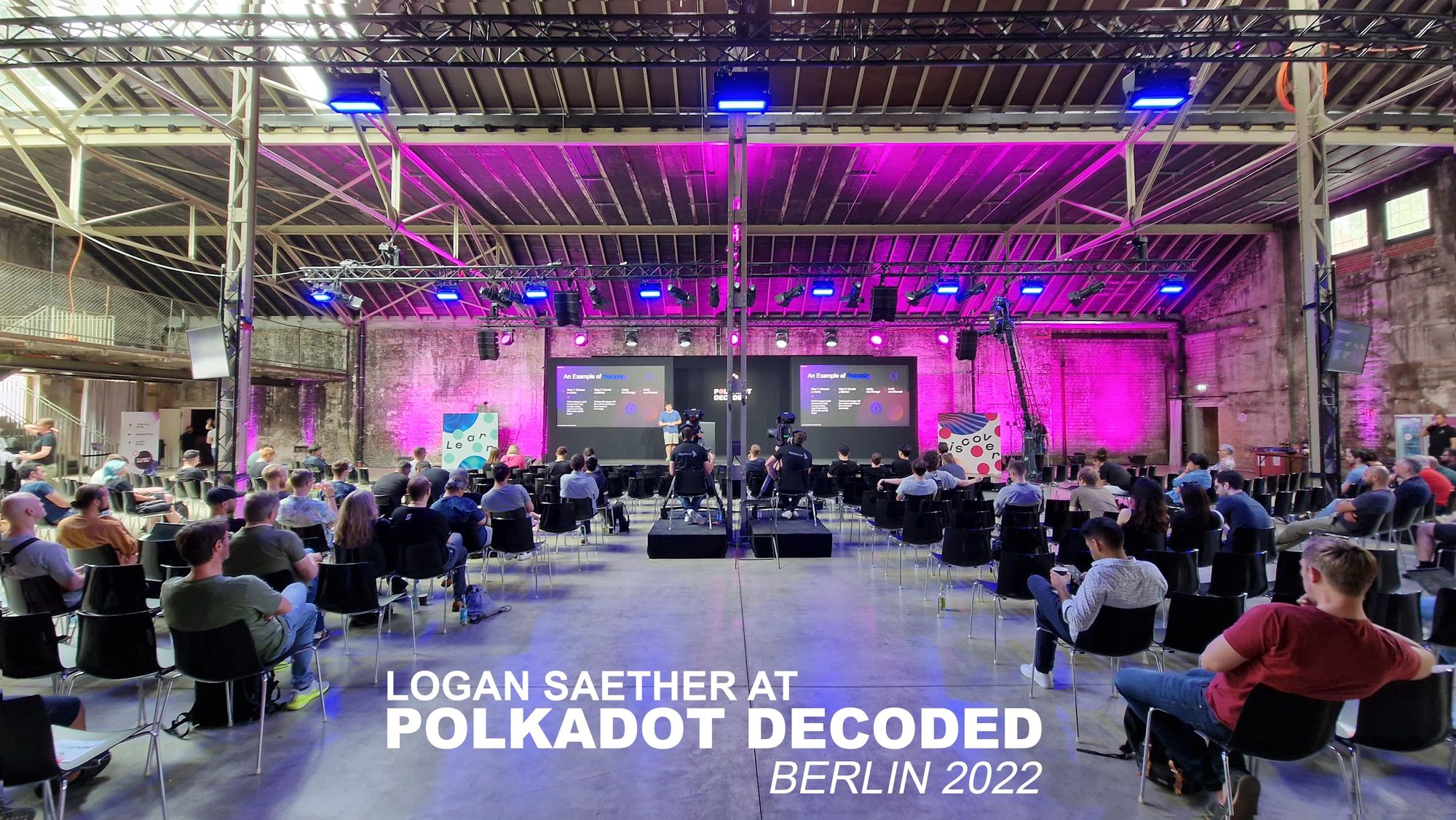
This is a transcription of the talk shared by our CEO Logan Saether at Polkadot Decoded Berlin 2022. The full video of the talk is embedded at the bottom of this post.
Over to Logan...
My (Logan Saether) history:
Web 3 Foundation: Tech education, where I built the Polkadot wiki. I also worked on tooling.
Last year, I left The Web3 Foundation to start Zeitgeist.
There are two parts to the mission statement behind Zeitgeist:
We’re building systems where the truth wins.
We’re building a blockchain for prediction markets and futarchy.
When I say truth, that means is: we’re using prediction markets to get a better signal on future events.
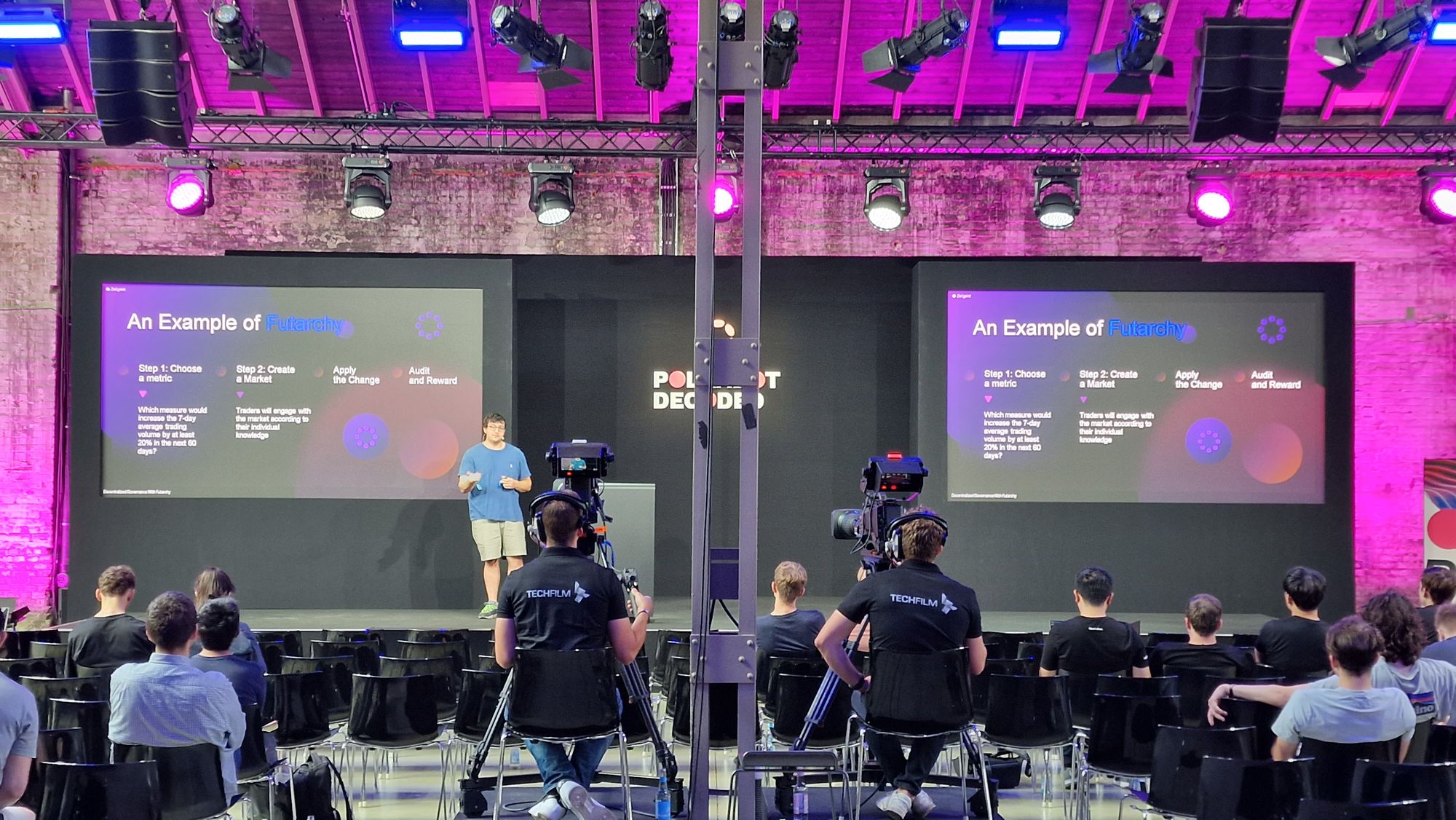
Who we are:
A permissionless protocol for trading, disputing and creating prediction markets, built with Substrate.
We deployed as the 19th parachain on Kusama (back in late 2021).
We’re targeting verticals of sports, e-sports, politics, and cutting edge things like crypto governance.
What are Prediction Markets?
Exchange based markets that trade on the outcome of a future event.
You can create a prediction market for just about anything that can happen in the future.
Through the trading mechanism you get a robust prediction of what might happen.
Most interesting part of prediction markets: You’re able to capture collective intelligence by crowdsourcing it from anyone in the world that can access the Zeitgeist chain.
Prediction markets provide incentives to people to reveal their knowledge about the outcome of an event.
If an expert in a specific subject matter sees a market is trading some knowledge that is incorrect, they can participate in that market and correct it and profit from their knowledge later.
Prediction markets have been around a while for some time.
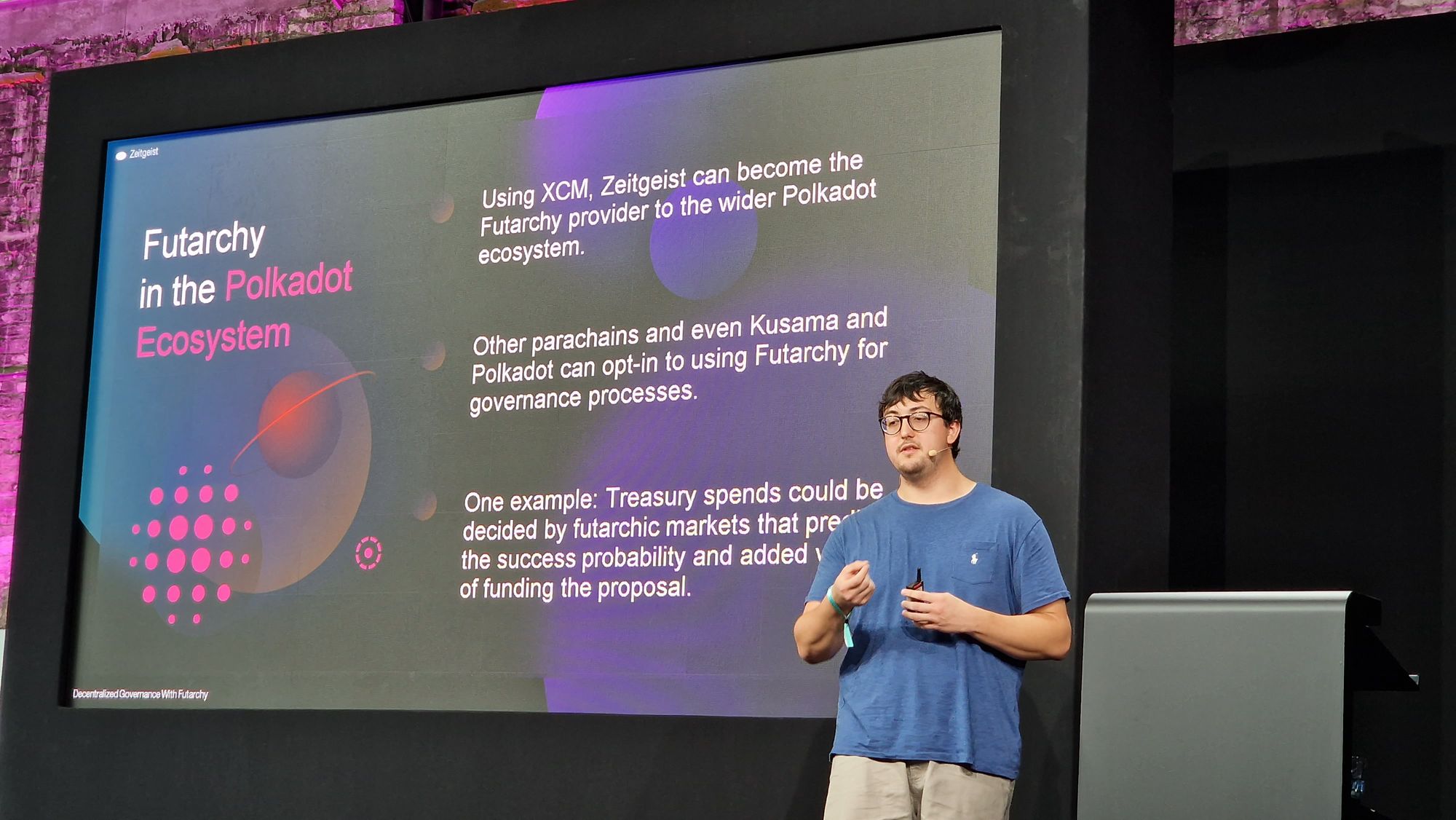
They've been used by the likes of Best Buy and even the US Government.
Four primary types of prediction markets:
Binary. Categorical. Scalar. Combinatorial.
We’ll break down the simplest form quickly: binary markets.
A market that trades on two outcomes:
- Yes, future event WILL take place.
- NO, future event won’t take place.
Only one of them can happen.
The prices of YES or NO are correlated (if YES goes up, NO will go down).
The winning asset is redeemed in the base asset of that market. (Stablecoin or ZTG)
While the market is trading, prices of the outcome assets change depending on how traders participate.
If YES is at 0.5 ztg (the Zeitgeist token), that equates to 50% probability the event will take place.
Now, back to our mission statement. The second part:
Truth is the ally of progress.
Here, we bridge from prediction markets (our machine for generating truth) to governance… a way to progress an organization.
Basics of blockchain governance: Blockchain introduced to us a new institution, and they are still evolving. And while they’re able to transition trust away from a centralized organization, there are still some unanswered questions around blockchain governance…
Who determines the rules - the software developers?
Can these rules change?
How do we know today’s rules don’t change tomorrow? If so, who determines that?
Then, let’s look at the problems of governance in general:
Aggregating information.
Perfect world: Everyone who votes has full knowledge of what they’re voting about. Very difficult to do! We don’t live in a “perfect” world.
A lack of incentive for people to vote. (Blockchain has low participation).
Risk of polarization.
People tend to vote along certain lines, and often double down and become increasingly polarized.
Running data driven democracies is costly. We see this in traditional democracies that haven’t transitioned to digital. But the problem is also there in blockchain governance.
Now we get to the star of the presentation:
FUTARCHY.
We’re proposing it as a possible solution to the above problems.
A governance system based on prediction markets and the signals we get from those markets.
Invented by Robin Hanson in his paper “Vote on Values, Bet on Beliefs”.
You can get an impression in that title of what he was thinking about: We want to separate what people want (what they’re doing with their voting) from the plan of how we achieve those wants.
Why this experiment?
We believe democracy is good… but it does suffer from information and co-ordination failures as it scales out.
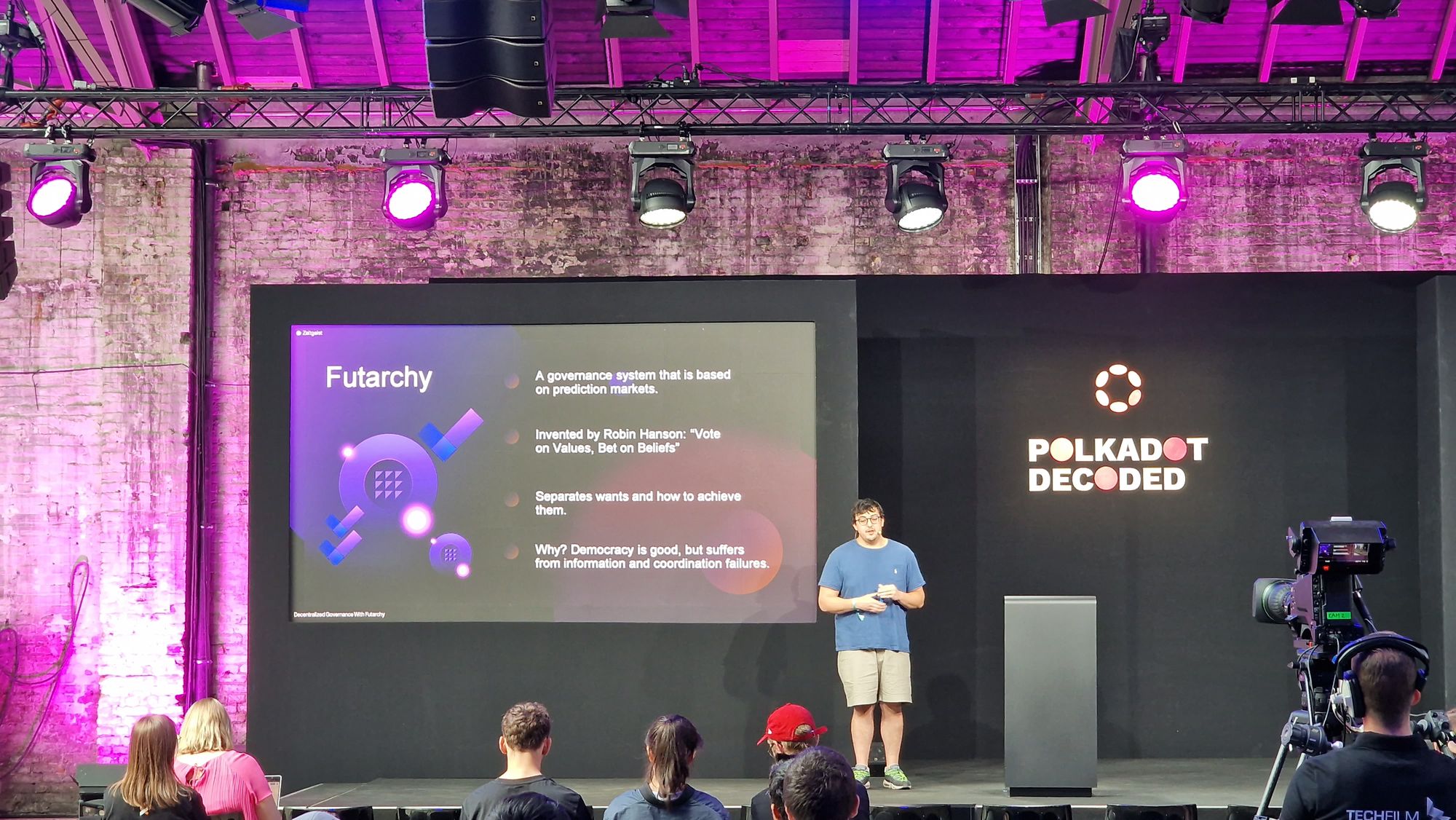
So, here’s an example of some steps of how a futarchy decision would play out (based on a blog post from our Research Fancisco de Pablo):
Step 1: Choose a metric that you’ll judge the proposal on.
For Zeitgeist, a good metric might be: Which measure out of a series of different measures will increase the 7 day trading volume by 20% over the next 60 days?
The more detailed and accurate you are with the constraints, the better. You’re narrowing down the possible noise.
Step 2: Create that market.
Deploy a new market on Zeitgeist, and open it to trading.
Each measure has equal probability at the outset.
We wait for the market lifecycle to conclude.
For example we see that “Plan A” has an 80% probability of increasing this metric.
Step 3: Apply that change (Plan A).
We then see what happens over the next 60 days.
Final step: Auditing that metric.
We confirm if the change did indeed work, and if so, we reward the voters of “Plan A” accordingly for giving us that information.
People have used futarchy in the past, but Zeitgeist wants to take futarchy further than we’ve seen before.
We want to bring it into a public space like a blockchain. Where there's permissionless participation, and see how it performs.
We’re incorporating futarchy as a core governance process of our own parachain.
We have our standard Substrate democracy and council pallet, but alongside those governance processes, we’ll deploy futarchy markets that will help us make decisions of how we progress our protocol.
Examples for us include: Transaction volume .Trading volume. Etc.
We’re still figuring exactly which metrics will be most beneficial to judge. It might be a combination of these. Essentially we want to increase the usage of Zeitgeist.
We also want to make futarchy available to the entire Polkadot ecosystem. We can do this using XCM.
Once we prove futarchy on our own parachain. War can allow other parachains to opt into that if they choose.
We can eventually incorporate this into polkadot core governance. EG. Through treasury spends.
(Treasury spends are when someone proposes to do something to the on-chain governance, and they get paid to go and do that.)
Running a futarchy market would allow us to have an indication of the success probability of funding this treasury proposal, and how much value this proposal would add to the ecosystem.
There are more examples we could do, but that’s one illustration.
That’s all I have time for in my slot today, but if you want to find out more, I encourage you to check out our blog, and join us on Discord where you can interact with our community and some of our team.
Thank you.
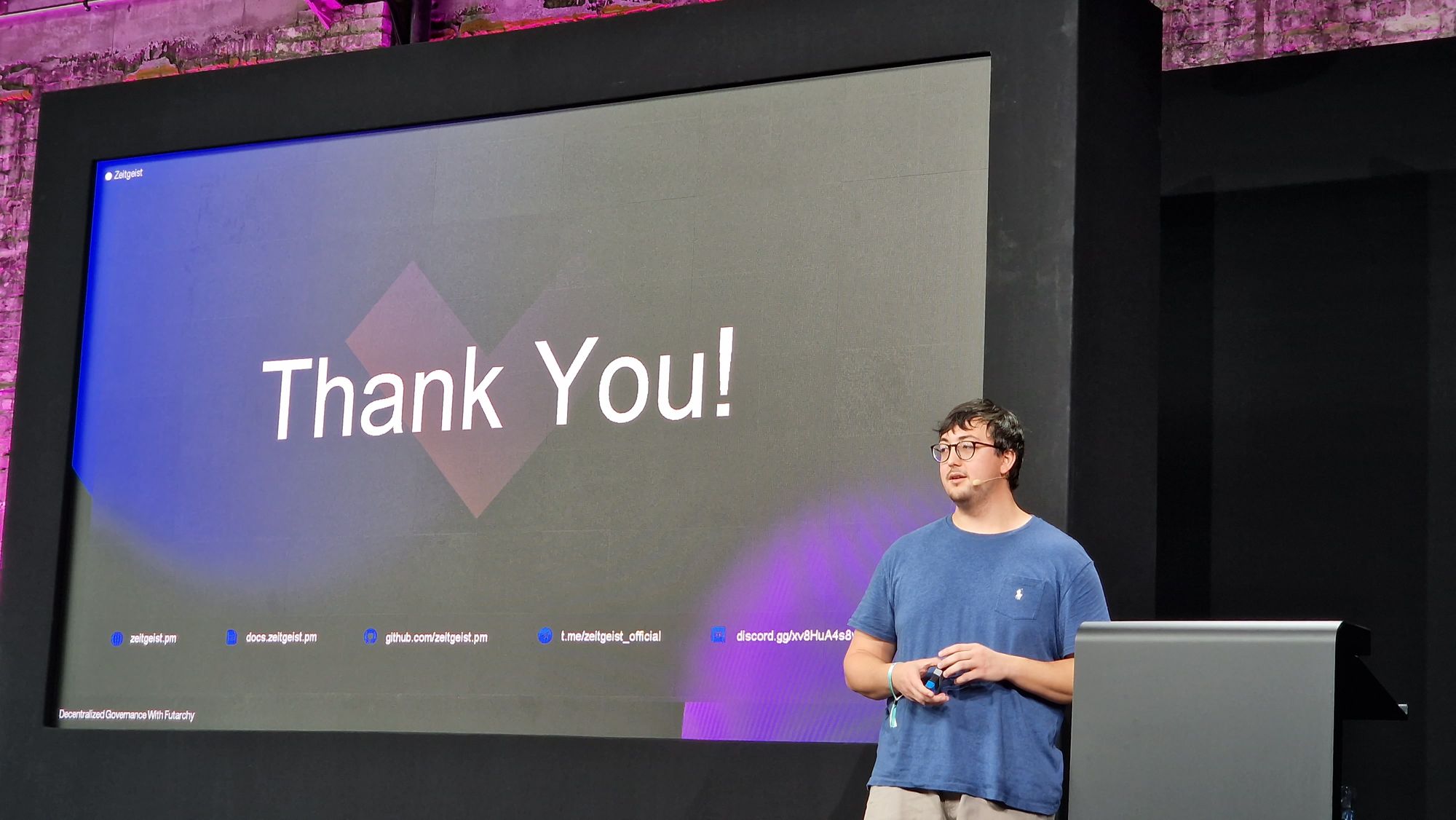
Happening now at @PolkadotDecoded 2022: @ZeitgeistPM`s @logansaether dives into how they are evolving decentralised #governance on @Polkadot
— kusama (@kusamanetwork) June 30, 2022
Watch the talk online: https://t.co/ORhQQ5ie36https://t.co/kx2J26gXL8
